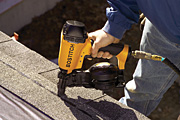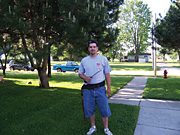Favorite Tools

David A. Stickle, DAS Roofing Company, Center, Texas
When David A. Stickle first used a Bostitch roofing coil nailer it was a perfect match. "I instantly fell in love," he says. "You can adjust the nail depth without constantly going up and down a ladder. It also has helped increase the productivity and energy of my crew."He first learned about the tool from his old boss, Daniel Morris. When he hung out his own shingle, one of his first purchases was the Bostitch nailer from Price Grabber for $210. Stickle likes the high-capacity coils that increase his productivity by allowing the crews to spend more time on the roof rather than reloading. "They are not making as many trips up and down to refill their nail pouches, as I do not allow a box or bucket of loose nails (on the roof)," he says, "thus keeping down the accidental nail being dropped and squashed into the roof."
The Bostitch nailer hasn't quite replaced Tawana ("Yes, I name each tool"), his trusty hatchet that takes care of the occasional under-driven nail.
Larry Fosgate, Ameritech Roofing Systems, Las Vegas
As a sales manager for Ameritech Roofing systems, Larry Fosgate has his work cut out for him. A hailstorm devastated Albuquerque, N.M., last October, affecting some 200,000 roofs. Ever since, Fosgate has been employing his favorite estimating tool: A 100-foot tape measure with a tennis ball stuck on the end. "It allows me to measure steep and fragile points on a roof without treading on them," he says.Fosgate doesn't play tennis, but picked up the technique from an insurance adjuster who said that the practice is widespread in his company. After cutting a slit in the ball, the end clip is inserted and the ball helps guide the tape over the roof terrain. It can even eliminate the ladder altogether since the ball is heavy enough to throw over a hip and reel in to the peak. The flexible and fuzzy surface also helps prevent damage to the current roof. While it helps his productivity, it still isn't enough to meet the current demand.
"Right now, I'm looking for more salesmen to canvas 200,000 hail-damaged homes," he says. "We are currently very active in Albuquerque."

Kevin Briesky, Pride Roofing, Sterling Heights, Mich.
Kevin Briesky is a throwback to the old craftsmen who, despite being president of the company, actually enjoys getting on the roof regularly. Some contractors don't want to be bothered with minor repairs or even residential jobs, but Briesky has carved out a niche for himself and his trusty flat bar. The tool comes in handy when only small areas of roofing material need to be torn off."I only use it for repairs, maybe a fascia too," he says. "When you do a repair, you can't just tear off a whole area."
He picked up the use of the flat bar from his first boss in the roofing business, allowing him to maneuver in tight quarters. They're cheap enough-around $6 at any home improvement store-to take at least two on the job, in case one slides off the roof. The work keeps him in touch with his crews and his craft. "I like repairs," he says. "With me doing the work I know it is done right and the only call-backs we will get are referrals."
Another item that works well with his flat bar on small jobs is the gas compressor for his Hitachi nail gun. "You've got to get yourself a gas compressor or else you're wasting time and electricity."
Al Smith, Al Smith Roofing, Lenox, Mass.
Al Smith still marvels at his favorite tool that he got with a 1987 purchase of a portable roll former from Englert. The second generation roofing contractor loves how his standing seamer just smoothly walks right up the panels like its namesake: R2D2. He uses three of them on the job and is glad to no longer be a tin knocker. "It does a beautiful job. Double hems and there's no hand work," he says, adding that sometimes the hand crimps come out for tight spots. "Every time we do I say, ‘Thank God we're not doing the whole roof like this.'"Smith's purchase of the portable roll former was held up for years over concerns about the price and the amount of work he could get from it. In fact, there was a time when he considered selling it because metal roofing wasn't that popular in the Northeast at the time. He talked to many architects, general contractors and building owners before creating a large customer base. Now he gets many referrals and favors residential projects over commercial ones.
"(Commercial jobs) tie you up for a long time," he says, adding that two or three residential jobs can be as profitable. "And if you lose your shirt (on a house), you're still in business."
Kieran Doyle, Halcyon Roofing, Clark, N.J.
Sometimes a new piece of equipment is a throwback to the old days. When Kieran Doyle saw the Wuko Eco Bender from North American Bocker a few years ago, he became one of the first to purchase the portable hand brake. Without computers or electricity, he custom makes flashing, pans and fold-ups on site."We use this right on the cut line and it makes a perfectly clean bend right there on the roof," he says. "It's paid me back. I'm always insane about my guys keeping it clean and in its box."
The self-described tool nut has been in roofing for 15 years and focuses his company on field installations. That's useful for steeples that call for tapered panels or when buildings don't measure the same as the drawings. He's even tied together hand brakes to make a continuous panel. To keep up on his tools, Doyle makes a trip to North American Bocker's "toy store" to test the latest gadgets himself.
"I use them all before I buy them," he says. "Installing is still an art. Workmanship is using two hands."
Rocco Rossi, Schena Roofing and Sheet Metal, Detroit
During his 30 years in roofing, Rocco Rossi has seen many products come and go. He installed his first single-ply, a PVC, in 1975, but still mops down the occasional coal-tar BUR for the automotive industry that wants a 50-year roof. The philosophy of "heat equals good roofing" may have a strong part in his favorite tool, a Leister heat welder."I believe the seams in the system should be heat welded," he says. "Even on some of the self-adhered modified bitumens, the top seams have to be heat welded."
Not all heat sources are good, according to Rossi. He used to own torches, but now believes that they have no place on the roof due to the risk of an open flame. His heat welder was one of the first purchases for his new company and he's never had a problem with it. The temperature is controlled and directs it right on the seam, even in windy weather. Now with TPOs making up more market share, his innovation 30 years ago is paying off. "I don't think you can put on a single-ply without them," he says. "It takes an inexpensive roof and makes it solidified."
Chris Underwood, Formation Roofing, Indianpolis
Chris Underwood has spent the last 25 years installing slate, tile and ornamental copper on historic and new structures. Much of that time was spent hauling material and equipment up and down the ladder or using a small lift unit, until he bought a conveyor from North American Bocker in 2000. He's still in awe of how easy it is to maneuver the 102-foot-long conveyor to just about any roof."It's so simple, you wouldn't believe it," he says. "You can back them around with a Bobcat or a small pickup truck."
Underwood figures he has cut his labor needs in half with the conveyor, placing all the material in strategic locations throughout the roof. In order to see the equipment in action, he regularly attends trade shows. A sales rep from North American Bocker even drove to Indianapolis to demonstrate the conveyor in person. He didn't buy one then but the timing was right soon enough to make that $70,000 investment. "We had a particular project where we needed that height," he says.
Looking for a reprint of this article?
From high-res PDFs to custom plaques, order your copy today!





